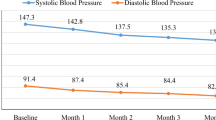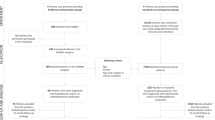Abstract
Hypertension is a leading cause of mortality and disease burden worldwide, yet its management remains suboptimal. Identification and management of lifestyle risk factors should be a clinical priority in all patients because of the beneficial effects of lifestyle intervention on blood pressure. The objective of this qualitative focus group study was to identify barriers to lifestyle management in hypertension in Australian general practice. Purposeful sampling was used to select large group practices. Six focus groups (n=30) were audio recorded and transcribed. An iterative thematic analysis was conducted. Overall participants felt they had the required knowledge to provide broad lifestyle advice. However, cynicism dominated due to an overwhelming lack of success in practice. Patient reluctance and ambivalence were identified as major barriers but participants were willing to share the responsibility. Other barriers included time, reduced access to allied health and broader determinants of health. General practitioners need to be empowered to allow continuation of valuable lifestyle advice and counselling. The results emphasise the importance of ongoing lifestyle assessment and tailoring of management to the complex interplay of factors that impact on a patient’s ability to adopt and maintain lifestyle change. System issues need to be addressed to provide better streamlined care.
This is a preview of subscription content, access via your institution
Access options
Subscribe to this journal
Receive 12 digital issues and online access to articles
$119.00 per year
only $9.92 per issue
Buy this article
- Purchase on Springer Link
- Instant access to full article PDF
Prices may be subject to local taxes which are calculated during checkout
Similar content being viewed by others
References
Briganti EM, Shaw JE, Chadban SJ, Zimmet PZ, Welborn TA, McNeil JJ et al. Untreated hypertension among Australian adults: the 1999-2000 Australian diabetes, obesity and lifestyle study (AusDiab). Med J Aust 2003; 179 (3): 135–139.
Nicoll R, Henein MY . Hypertension and lifestyle modification: how useful are the guidelines? Br J Gen Pract 2010; 60 (581): 879–880.
Cutler JA, Sorlie PD, Wolz M, Thom T, Fields LE, Roccella EJ . Trends in hypertension prevalence, awareness, treatment, and control rates in United States adults between 1988–1994 and 1999–2004. Hypertension 2008; 52 (5): 818–827.
Falaschetti E, Chaudhury M, Mindell J, Poulter N . Continued improvement in hypertension management in England: results from the Health Survey for England 2006. Hypertension 2009; 53 (3): 480–486.
Howes F, Hansen E, Williams D, Nelson M . Barriers to diagnosing and managing hypertension—a qualitative study in Australian general practice. Aust Fam Physician 2010; 39 (6): 511–516.
Britt H, Miller GC, Charles J, Henderson J, Bayram C, Pan Y et al General practice activity in Australia 2008-09. Cat. no. GEP 25. AIHW: Canberra, 2009.
Margolius D, Bodenheimer T . Controlling hypertension requires a new primary care model. Am J Manag Care 2010; 16 (9): 648–650.
Australian Institute of Health and Welfare. Chronic diseases and associated risk factors in Australia, In AIHW: Canberra, 2006.
Egger G, Binns A, Rossner S . Lifestyle Medicine. McGraw-Hill: Sydney, 2011.
Chobanian AV, Bakris GL, Black HR, Cushman WC, Green LA, Izzo JL et al. The seventh report of the Joint National Committee on prevention, detection, evaluation, and treatment of high blood pressure: the JNC 7 report. JAMA 2003; 289 (19): 2560–2572.
National Heart Foundation of Australia (National Blood Pressure and Vascular Disease Advisory Committee). Guide to management of hypertension 2008 Updated 2010.
Williams B, Poulter NR, Brown MJ, Davis M, McInnes GT, Potter JF et al. Guidelines for management of hypertension: report of the fourth working party of the British Hypertension Society, 2004-BHS IV. J Hum Hypertens 2004; 18 (3): 139–185.
Sacks FM, Svetkey LP, Vollmer WM, Appel LJ, Bray GA, Harsha D et al. Effects on blood pressure of reduced dietary sodium and the dietary approaches to stop hypertension (DASH) diet. DASH-Sodium Collaborative Research Group. N Engl J Med 2001; 344 (1): 3–10.
Harris M, Lloyd J . The role of Australian primary health care in the prevention of chronic disease. In: Australian National Preventive Health Agency. Australian Government, 2012.
Brotons C, Bjorkelund C, Bulc M, Ciurana R, Godycki-Cwirko M, Jurgova E et al. Prevention and health promotion in clinical practice: the views of general practitioners in Europe. Prev Med 2005; 40 (5): 595–601.
Laws RA, Kirby SE, Davies GP, Williams AM, Jayasinghe UW, Amoroso CL et al. ‘Should I and can I?’ A mixed methods study of clinician beliefs and attitudes in the management of lifestyle risk factors in primary health care. BMC Health Serv Res 2008; 8: 44.
Vickers KS, Kircher KJ, Smith MD, Petersen LR, Rasmussen NH . Health behavior counseling in primary care: provider-reported rate and confidence. Fam Med 2007; 39 (10): 730–735.
Kushner RF . Barriers to providing nutrition counseling by physicians: a survey of primary care practitioners. Prev Med 1995; 24 (6): 546–552.
Bull FC, Schipper EC, Jamrozik K, Blanksby BA . Beliefs and behaviour of general practitioners regarding promotion of physical activity. Aust J Public Health 1995; 19 (3): 300–304.
Cook S, Drum ML, Kirchhoff AC, Jin L, Levie J, Harrison JF et al. Providers’ assessment of barriers to effective management of hypertension and hyperlipidemia in community health centers. J Health Care Poor Underserved 2006; 17 (1): 70–85.
Cornuz J, Ghali WA, Di Carlantonio D, Pecoud A, Paccaud F . Physicians’ attitudes towards prevention: importance of intervention-specific barriers and physicians' health habits. Fam Pract 2000; 17 (6): 535–540.
Jallinoja P, Absetz P, Kuronen R, Nissinen A, Talja M, Uutela A et al. The dilemma of patient responsibility for lifestyle change: perceptions among primary care physicians and nurses. Scand J Prim Health Care 2007; 25 (4): 244–249.
Lambe B, Collins C . A qualitative study of lifestyle counselling in general practice in Ireland. Fam Pract 2010; 27 (2): 219–223.
Gee ME, Bienek A, Campbell NR, Bancej CM, Robitaille C, Kaczorowski J et al. Prevalence of, and barriers to, preventive lifestyle behaviors in hypertension (from a national survey of Canadians with hypertension). Am J Cardiol 2012; 109 (4): 570–575.
Gregory S, Bostock Y, Backett-Milburn K . Recovering from a heart attack: a qualitative study into lay experiences and the struggle to make lifestyle changes. Fam Pract 2006; 23 (2): 220–225.
Joyner-Grantham J, Mount DL, McCorkle OD, Simmons DR, Ferrario CM, Cline DM . Self-reported influences of hopelessness, health literacy, lifestyle action, and patient inertia on blood pressure control in a hypertensive emergency department population. Am J Med Sci 2009; 338 (5): 368–372.
Prochaska JJ . Failure to treat tobacco use in mental health and addiction treatment settings: a form of harm reduction? Drug Alcohol Depend 2010; 110 (3): 177–182.
Ragg M, Ahmed T . Smoke and mirrors: a review of the literature on smoking and mental illness. Cancer Council NSW: Sydney, 2008.
Artinian N, Fletcher G, Mozaffarian D, Kris-Etherton P, Van Horn L, Lichtenstein A et al. Interventions to promote physical activity and dietary lifestyle changes for cardiovascular risk factor reduction in adults: a scientific statement from the American Heart Association. Circulation 2010; 122 (4): 406–441.
Noordman J, Verhaak P, van Dulmen S . Discussing patient’s lifestyle choices in the consulting room: analysis of GP-patient consultations between 1975 and 2008. BMC Fam Pract 2010; 11: 87.
Milder IE, Blokstra A, de Groot J, van Dulmen S, Bemelmans WJ . Lifestyle counseling in hypertension-related visits—analysis of video-taped general practice visits. BMC Fam Pract 2008; 9: 58.
Bandura A . Self-efficacy. In: Ramachaudran VS, (ed). Encyclopedia of human behavior. Academic Press: New York, 1994.
Lobelo F, Duperly J, Frank E . Physical activity habits of doctors and medical students influence their counselling practices. Br J Sports Med 2009; 43 (2): 89–92.
Freeman AC, Sweeney K . Why general practitioners do not implement evidence: qualitative study. BMJ 2001; 323 (7321): 1100–1102.
Henderson JT, Weisman CS . Physician gender effects on preventive screening and counseling: an analysis of male and female patients’ health care experiences. Med Care 2001; 39 (12): 1281–1292.
Schmittdiel JA, Traylor A, Uratsu CS, Mangione CM, Ferrara A, Subramanian U . The association of patient-physician gender concordance with cardiovascular disease risk factor control and treatment in diabetes. J Womens Health 2009; 18 (12): 2065–2070.
Pittrow D, Kirch W, Bramlage P, Lehnert H, Hofler M, Unger T et al. Patterns of antihypertensive drug utilization in primary care. Eur J. Clin Pharmacol 2004; 60 (2): 135–142.
Hansen EC . Successful qualitative health research: a practical introduction. Allen & Unwin: NSW, 2006.
Berg BL . Qualitative research methods for the social sciences 5th (edn). Pearson: Boston, 2004.
Acknowledgements
This work was supported by the Royal Australian College of General Practitioners Research Foundation through a Cardiovascular Research Grant in General Practice and the National Heart Foundation of Australia through a Post Graduate Clinical Scholarship. The project was approved by the Human Research Ethics Committee (Tasmania) Network (approval number H9301). We thank Dr Emily Hansen (ECH) for her mentorship and assistance with the analysis of the original study and the general practitioners who participated in this study.
Author information
Authors and Affiliations
Corresponding author
Ethics declarations
Competing interests
The authors declare that they have no conflict of interest.
Rights and permissions
About this article
Cite this article
Howes, F., Warnecke, E. & Nelson, M. Barriers to lifestyle risk factor assessment and management in hypertension: a qualitative study of Australian general practitioners. J Hum Hypertens 27, 474–478 (2013). https://doi.org/10.1038/jhh.2013.9
Received:
Revised:
Accepted:
Published:
Issue Date:
DOI: https://doi.org/10.1038/jhh.2013.9
Keywords
This article is cited by
-
Alzheimer’s disease risk reduction in clinical practice: a priority in the emerging field of preventive neurology
Nature Mental Health (2024)
-
Content and delivery preferences for information to support the management of high blood pressure
Journal of Human Hypertension (2022)
-
Prescription of physical activity in the management of high blood pressure in Australian general practices
Journal of Human Hypertension (2019)
-
Supporting the self-management of hypertension: Patients’ experiences of using a mobile phone-based system
Journal of Human Hypertension (2016)



